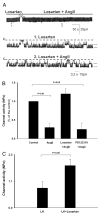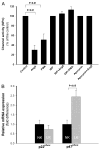Angiotensin II inhibits the ROMK-like small conductance K channel in renal cortical collecting duct during dietary potassium restriction
- PMID: 17194699
- PMCID: PMC2822470
- DOI: 10.1074/jbc.M607477200
Angiotensin II inhibits the ROMK-like small conductance K channel in renal cortical collecting duct during dietary potassium restriction
Abstract
Base-line urinary potassium secretion in the distal nephron is mediated by small conductance rat outer medullary K (ROMK)-like channels. We used the patch clamp technique applied to split-open cortical collecting ducts (CCDs) isolated from rats fed a normal potassium (NK) or low potassium (LK) diet to test the hypothesis that AngII directly inhibits ROMK channel activity. We found that AngII inhibited ROMK channel activity in LK but not NK rats in a dose-dependent manner. The AngII-induced reduction in channel activity was mediated by AT1 receptor (AT1R) binding, because pretreatment of CCDs with losartan but not PD123319 AT1 and AT2 receptor antagonists, respectively, blocked the response. Pretreatment of CCDs with U73122 and calphostin C, inhibitors of phospholipase C (PLC) and protein kinase C (PKC), respectively, abolished the AngII-induced decrease in ROMK channel activity, confirming a role of the PLC-PKC pathway in this response. Studies by others suggest that AngII stimulates an Src family protein-tyrosine kinase (PTK) via PKC-NADPH oxidase. PTK has been shown to regulate the ROMK channel. Inhibition of NADPH oxidase with diphenyliodonium abolished the inhibitory effect of AngII or the PKC activator phorbol 12-myristate 13-acetate on ROMK channels. Suppression of PTK by herbimycin A significantly attenuated the inhibitory effect of AngII on ROMK channel activity. We conclude that AngII inhibits ROMK channel activity through PKC-, NADPH oxidase-, and PTK-dependent pathways under conditions of dietary potassium restriction.
Figures








Similar articles
-
Decrease in dietary K intake stimulates the generation of superoxide anions in the kidney and inhibits K secretory channels in the CCD.Am J Physiol Renal Physiol. 2010 Jun;298(6):F1515-22. doi: 10.1152/ajprenal.00502.2009. Epub 2010 Mar 31. Am J Physiol Renal Physiol. 2010. PMID: 20357031 Free PMC article.
-
Angiotensin II type 2 receptor regulates ROMK-like K⁺ channel activity in the renal cortical collecting duct during high dietary K⁺ adaptation.Am J Physiol Renal Physiol. 2014 Oct 1;307(7):F833-43. doi: 10.1152/ajprenal.00141.2014. Epub 2014 Aug 6. Am J Physiol Renal Physiol. 2014. PMID: 25100281 Free PMC article.
-
Mitogen-activated protein kinases inhibit the ROMK (Kir 1.1)-like small conductance K channels in the cortical collecting duct.J Am Soc Nephrol. 2006 Oct;17(10):2687-96. doi: 10.1681/ASN.2006050426. Epub 2006 Sep 13. J Am Soc Nephrol. 2006. PMID: 16971657 Free PMC article.
-
Renal potassium channels: recent developments.Curr Opin Nephrol Hypertens. 2004 Sep;13(5):549-55. doi: 10.1097/00041552-200409000-00011. Curr Opin Nephrol Hypertens. 2004. PMID: 15300162 Review.
-
Effects of angiotensin II on kinase-mediated sodium and potassium transport in the distal nephron.Curr Opin Nephrol Hypertens. 2013 Jan;22(1):120-6. doi: 10.1097/MNH.0b013e32835b6551. Curr Opin Nephrol Hypertens. 2013. PMID: 23165113 Review.
Cited by
-
Protein kinase C mediated pH(i)-regulation of ROMK1 channels via a phosphatidylinositol-4,5-bisphosphate-dependent mechanism.J Mol Model. 2012 Jul;18(7):2929-41. doi: 10.1007/s00894-011-1266-2. Epub 2011 Dec 3. J Mol Model. 2012. PMID: 22139477
-
Paracellular transport in the collecting duct.Curr Opin Nephrol Hypertens. 2016 Sep;25(5):424-8. doi: 10.1097/MNH.0000000000000253. Curr Opin Nephrol Hypertens. 2016. PMID: 27490784 Free PMC article. Review.
-
NADPH oxidases, reactive oxygen species, and the kidney: friend and foe.J Am Soc Nephrol. 2013 Oct;24(10):1512-8. doi: 10.1681/ASN.2012111112. Epub 2013 Aug 22. J Am Soc Nephrol. 2013. PMID: 23970124 Free PMC article. Review.
-
Recent advances in understanding integrative control of potassium homeostasis.Annu Rev Physiol. 2009;71:381-401. doi: 10.1146/annurev.physiol.010908.163241. Annu Rev Physiol. 2009. PMID: 18759636 Free PMC article. Review.
-
AT2 receptors in cortical collecting ducts: a novel role in mediating ROMK-like K(+) channel responses to high dietary K(+)?Am J Physiol Renal Physiol. 2014 Nov 15;307(10):F1134-5. doi: 10.1152/ajprenal.00479.2014. Epub 2014 Sep 3. Am J Physiol Renal Physiol. 2014. PMID: 25186295 Free PMC article. No abstract available.
References
-
- Linas SL, Peterson LN, Anderson RJ, Aisenbrey GA, Simon FR, Berl T. Kidney Int. 1979;15:601–611. - PubMed
-
- Okusa MD, Unwin RJ, Velazquez H, Giebisch G, Wright FS. Am J Physiol. 1992;262:F488–F493. - PubMed
-
- Giebisch G. Am J Physiol. 1998;274:F817–F833. - PubMed
-
- Najjar F, Zhou H, Morimoto T, Bruns JB, Li HS, Liu W, Kleyman TR, Satlin LM. Am J Physiol. 2005;289:F922–F932. - PubMed
-
- Boim MA, Ho K, Shuck ME, Bienkowski MJ, Block JH, Slightom JL, Yang Y, Brenner BM, Hebert SC. Am J Physiol. 1995;268:F1132–F1140. - PubMed
Publication types
MeSH terms
Substances
Grants and funding
LinkOut - more resources
Full Text Sources
Medical
Research Materials
Miscellaneous

